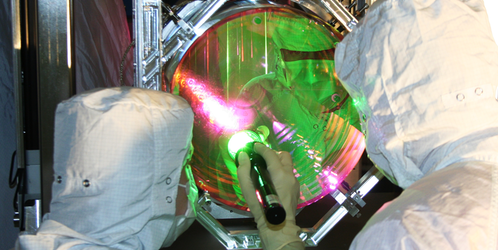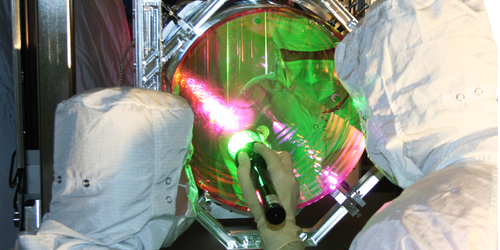Mirror, Mirror—Which Coating is the Quietest of Them All
To detect the faint “chirps” of gravitational waves, researchers at the upgraded facilities of Advanced LIGO and Virgo must minimize noise as much as possible. One of the most troublesome sources of noise in these detectors is the thermal fluctuations in the mirror coatings. Iain Martin from the University of Glasgow, UK, and colleagues now propose a new coating material that could help reduce thermal noise at temperatures of around 10 K, where the next generation of gravitational-wave detectors plan to operate.
Gravitational-wave detectors use kilometer-long interferometer arms formed by laser beams bouncing off highly reflective mirrors (see 11 February 2016 Viewpoint). To maximize reflection, the mirrors are coated with alternating layers of materials that have high and low refractive indices. The coatings create an interference effect that reduces light absorption to less than 5 parts per million.
In current detectors, the coatings are made of doped tantala and silica . But both of these materials exhibit strong mechanical losses—which means vibrations are readily converted to heat and thermal fluctuations—at the low temperatures planned for next-generation detectors, such as the Einstein Telescope.
Martin and colleagues propose replacing the silica with a low-index material called hafnia . In tests, the team placed thin films of hafnia (doped with silica) on a cantilever and measured the material’s mechanical loss to be a factor of 2 lower than that of pure silica. They also calculated the expected performance of a coating design consisting mainly of hafnia and amorphous silicon (a tantala replacement). The researchers found that this model coating would be 25 times less noisy than current LIGO coatings for low-frequency (10-Hz) gravitational waves, the detection of which is one of the design goals for the Einstein Telescope.
This research is published in Physical Review Letters.
–Michael Schirber
Michael Schirber is a Corresponding Editor for Physics based in Lyon, France.
Correction (14 June 2019): The article was corrected to say that the expected noise-reduction factor for the coating is 25, not 100.





